Top 8 Features of Ticket Redemption Kiosks for Arcades and Casinos
Discover the top 8 features of ticket redemption kiosks for arcades and casinos that make speed up transactions, and improve player satisfaction and efficiency.
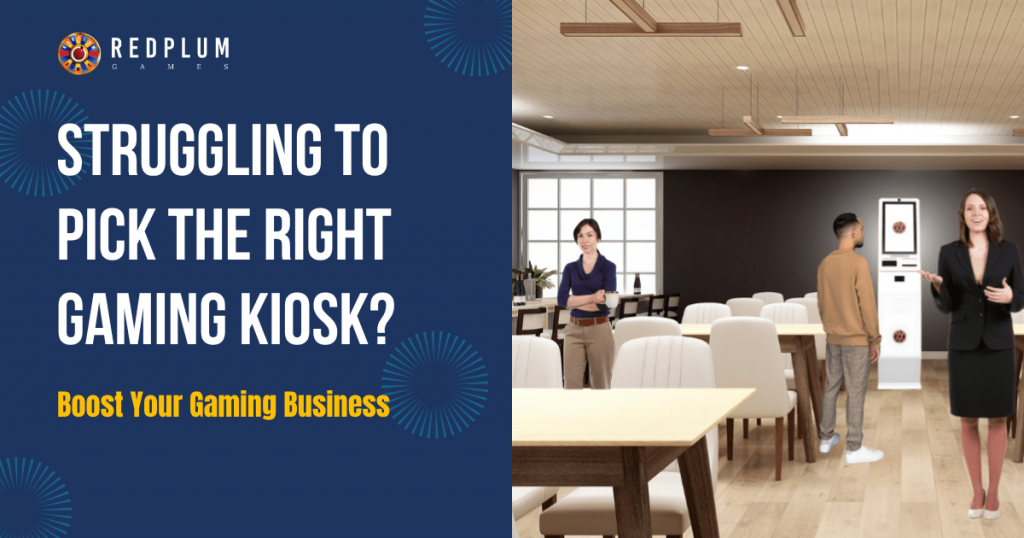
Selecting the appropriate gaming kiosk is not based on selecting the most costly or feature-packed one available. It’s about choosing the one that best fits your location, audience, and desired type of experience. The best guide to buy gaming kiosk highlights why a setup that works in a buzzing arcade might fail in a quiet café or hotel lobby.
Imagine a large esports kiosk housed inside a little coffee shop. Though it looks great, it won’t be used if it consumes too much space or throws off the atmosphere. Imagine now a little, elegant touch screen gaming kiosk in the same café where patrons wait for their order by playing quick games. That fits far better and most certainly makes more money.
This is the reason the word right counts more than top. Choosing a kiosk depends mostly on matching it to your environment rather than merely following trends.
Many times, companies want the best-rated kiosk without considering where it will be used. But different places have different purposes.
A top-notch gaming kiosk could have immersive Skill Games, LED lighting, and first-rate audio loaded on it. Still, consider whether your location would enable that. Actually, do your clients want that kind of arrangement?
Here’s what usually makes more sense:
It’s about choosing the one that best fits your surroundings and provides people with a reason to stroll up and play, not about selecting the most advanced option.
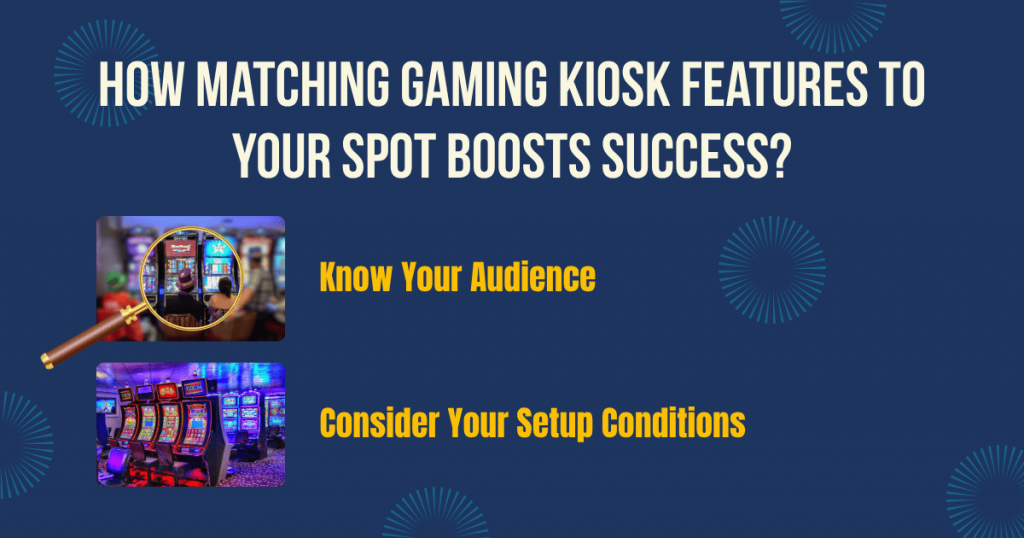
People naturally want to interact with a kiosk when it fits the spot. More playtime, more foot traffic, and higher income follow from this. Emphasize three main areas—your audience, your space, and your configuration—to get this perfect.
The kind of player you aim for should direct your choice. Consider the visitors to your site and what kind of gaming experience fits them?
For example:
Apart from the audience, the correct unit is much influenced by the technical and physical configuration.
People won’t use a nice-looking kiosk if it seems antiquated or confusing. Easy to grasp and simple to operate kiosks are the ones that excel.
Look for features like:
A well-matched gaming kiosk draws your audience, fits your location, and promotes return business. That is what makes it “right”—not only loaded features or premium specs.
Your company benefits more when your machine fits your space.
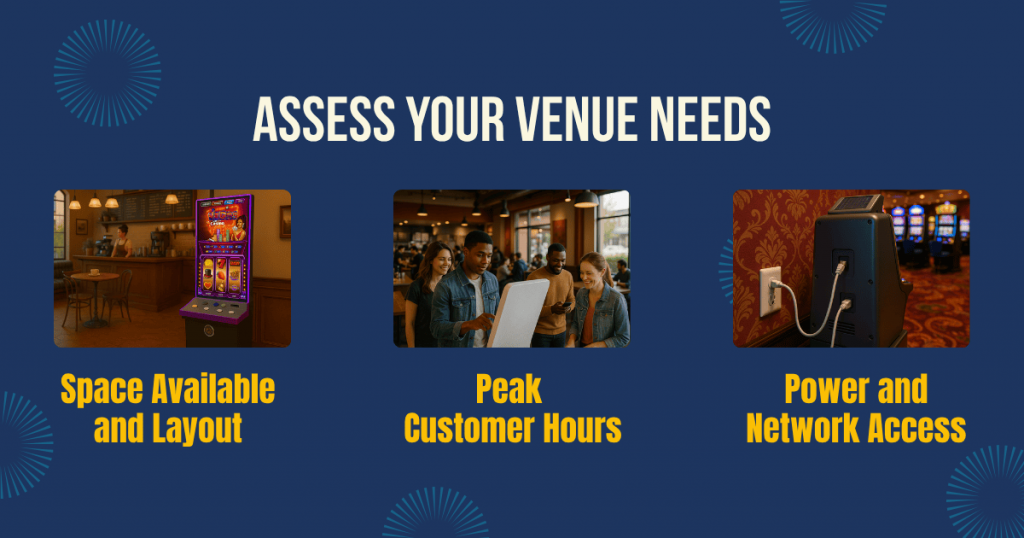
Look around your area closely before choosing a gaming kiosk. The degree of success of your arrangement will rely on how well the kiosk conforms to your surroundings—not only physically but also in terms of the flow of people and energy in the surroundings.
Some companies choose the kiosk first and then start to worry about space later. This sometimes results in blocked doors, narrow passways, or abandoned equipment. Starting with the basics of your location will help you to avoid that.
Measure exactly where you wish to install the kiosk. Not only the width and height but also people’s movement across that space. Is it tucked between other machines or furniture or in a broad-open hallway?
Think about:
With regard to usability and comfort, even a few inches can make a difference.
Though they seem basic, gaming kiosks require constant power and occasionally a reliable internet connection—especially for remote updates or payment capabilities.
Check:
If your area lacks robust infrastructure, relax; there are models designed to function with restricted access. The secret is to choose based on what is practical rather than what you intend to install later.
At your location, the busiest times of day count. You want a kiosk that interacts with your crowd, not against it.
Ask yourself:
Should your venue get crowded within limited time frames, you will want a kiosk capable of handling quick interactions or serving several users. People can then enjoy it without slowing down everything.
Spending time to evaluate your space, layout, and calendar helps you to better understand the type of gaming kiosk that would really be appropriate. It’s about where it will perform best rather than only where it can go.
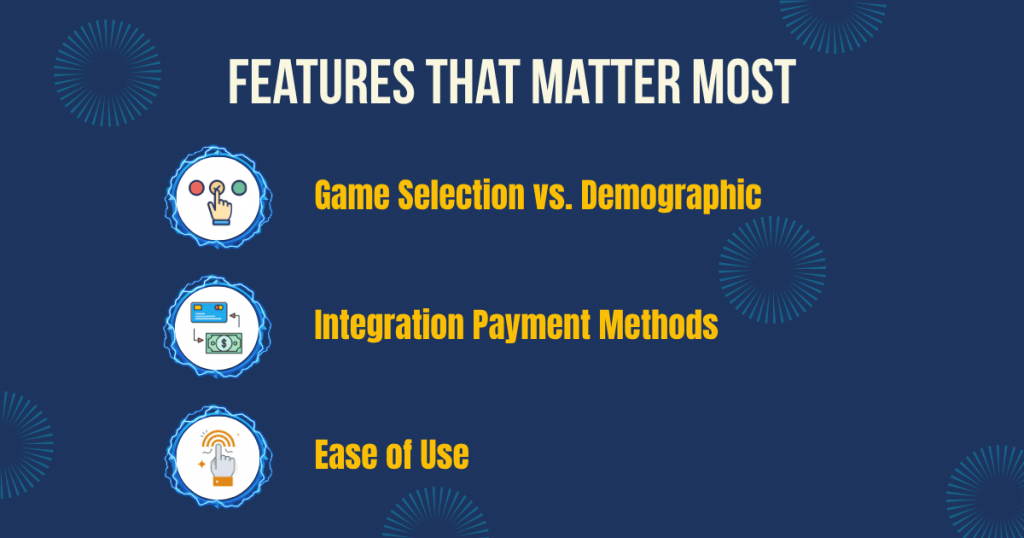
Bright colors and game diversity easily capture one’s attention. When it comes to actual performance, though, the elements that most count are those that appeal to your clients. A kiosk is a mini experience, not only a tool. And the correct elements make that experience seamless, entertaining, and worth returning to.
Let’s break down the key features that actually make a difference.
You might have a 100 game kiosk loaded, but if none of them appeal to your audience it won’t be used.
Think about who visits your space:
Matching the game type to the audience keeps people interested longer—and more likely to return.
None want to wait for change or search for coins. People of today want simple, seamless methods of playing and paying. This makes having flexible payment choices rather important.
A good kiosk should offer:
That’s a warning sign if your clients have to ask how to pay. People are more likely to jump in the more simple it is to start playing.
You have lost them if someone approaches the kiosk unsure of what to do next. Even someone first using your interface should find it to be natural.
Key elements that help:
This is especially crucial if your audience consists of elderly persons as well as children. Both usually overlook a setup too complicated for one group.
By emphasizing the correct features—ones that fit your audience, streamline payments, and feel simple to use—a good gaming kiosk can become a great one. Not to wow with intricacy is the aim. It’s to link via straightforward, clever design.
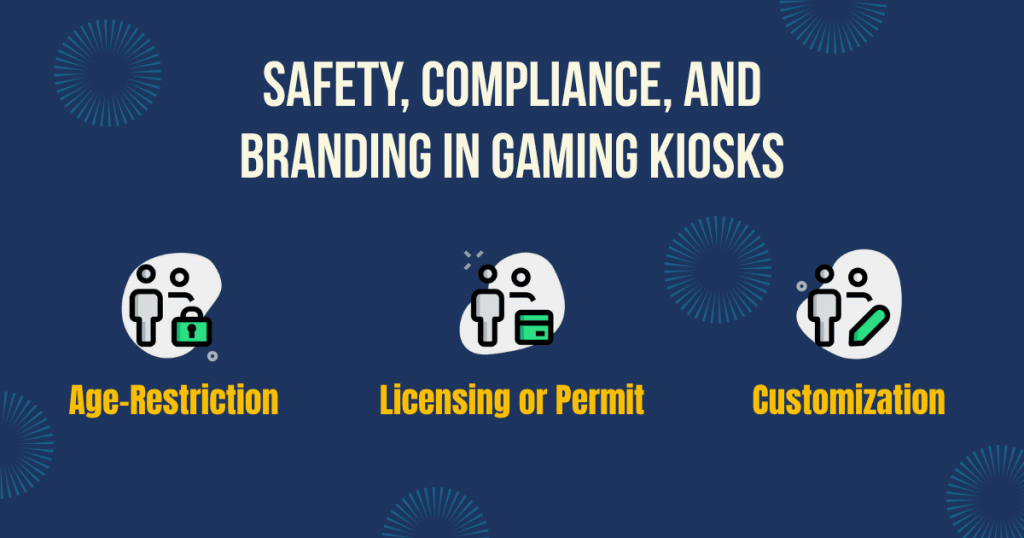
A gaming kiosk must follow policies and reflect your brand in addition to providing entertainment value. Whether your venue is a casino, mall, gas station, or café, you have to consider how safe it is for consumers, whether it satisfies local laws, and how best it fits your corporate image.
Ignoring these components might cause legal problems, bad customer confidence, or a kiosk that simply feels out of place
Some games, particularly in venues like casinos or esports zones, are designed only for adults. You need correct filters if younger guests have access.
Smart kiosks let you:
This not only maintains your brand reputation but also legally protects you and builds confidence with families.
Not every venue lets gaming kiosks operate without permission. And rules might differ between cities as well.
Before you buy or install a unit:
Even skill-based games are sometimes handled in some places as gambling machines. Later on, a brief call to your local licensing body can save a lot of money and hassle.
Branding your kiosk gives it more of a businesslike appearance than just a machine kept in the corner. It creates consistency over your area and facilitates memory of your name.
You can:
These little tweaks improve the professionalism and integration of your arrangement. It indicates to consumers that the experience you have considered is not merely dropped in a machine.
Though they may not sound interesting, safety, compliance, and branding make all the difference between a temporary arrangement and a long-term success. More trust and repeat use come from a kiosk that follows regulations and resembles something from your company.

Purchasing a gaming kiosk goes beyond only the machine’s cost. You must budget for all the expenses—upfront, continuing, and unanticipated if you want to remain profitable.
Hidden fees or little monthly charges that mount up over time often surprise many companies. A well-designed budget ensures your kiosk generates more money than it consumes and helps you avoid surprises.
First, let’s address the obvious one: the machine’s own cost.
Features, size, and technological capability all affect prices. Some kiosks run a few hundred dollars, others in the thousands. But keep in mind also:
To find the actual upfront cost, ask for a complete quote covering delivery through setup.
Certain gaming kiosks include software license fees or service agreements. Others are set up on a revenue-sharing arrangement whereby the supplier or manufacturer absorbs a percentage of the profits.
Here’s what to watch for:
Make sure you know how much you retain from every game you run through. A 70/30 split in your favor sounds great, but not if the support and upkeep are inadequate.
Like every machine, kiosks might need repairs or updates. Ignoring these can cost you downtime as well as money.
Potential extra costs include:
Find out from your supplier: How much yearly maintenance is average? Do software updates cost anything? Should something break, what happens?
Budgeting does not finish with the purchase. It’s about knowing what’s ahead and always being ready. When you make plans for the whole picture, you safeguard your gains and prevent future problems.
Finding the correct supplier comes next once you know what kind of kiosk you require and how your budget looks. Though their machines look similar, not all suppliers are the same.
Not only does their quality of products define them uniquely. Their approach to problems, speed of response, and degree of support for you following the sale define them.
Here are the key things to check before choosing a supplier.
A good warranty indicates that the supplier supports their goods. A weak one raises some questions.
Look for:
A solid 12-month or 24-month warranty can save hundreds on unanticipated repairs.
Problems can arise even with a great kiosk. Time becomes important when that occurs. A supplier who responds fast will help to minimise your downtime and safeguard your income.
Inquire with these questions:
Fast service keeps your kiosk running and keeps users from leaving.
Those who have already dealt with a supplier can teach a lot. That is a major warning sign if others have negative experiences with slow support or defective hardware.
Here’s how to check:
Real comments paint a clearer picture than sales promises will ever allow.
Selecting a suitable supplier calls for more than just cost. It’s about confidence, hospitality, and long-term assistance. Your kiosk investment can be profitable and stress-free depending on a trustworthy supplier. A bad one could cost you consumers, money, and time.
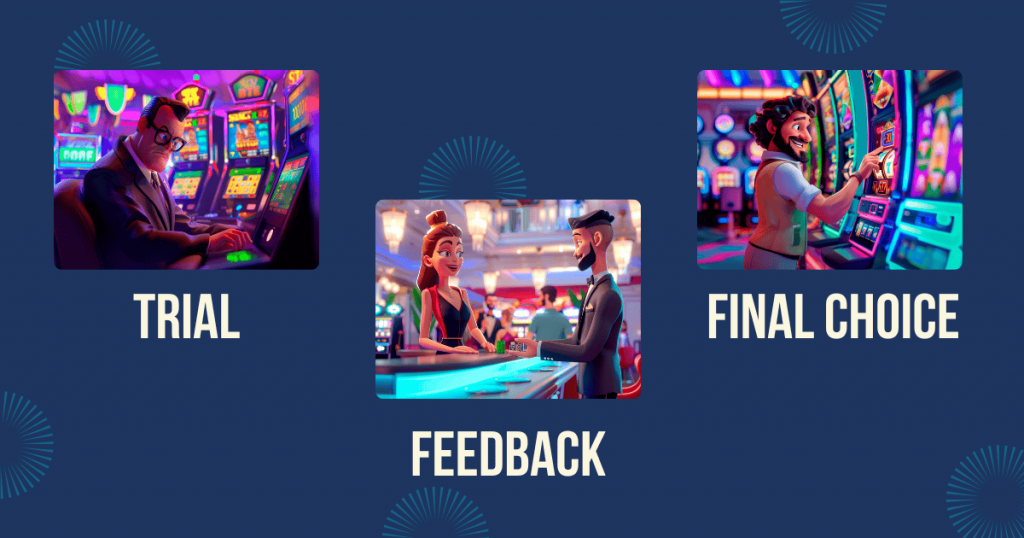
The true test is how a gaming kiosk performs in your space—with your actual users—even if it looks ideal on paper. Running a small trial before entering all-in will thus save time, money, and aggravation.
Consider it a test drive. Before you commit to a complete rollout, you can see how the kiosk fits, how consumers respond, and whether anything has to be changed.
Start one unit in one place. Choose a location with regular traffic so you may quickly gather pertinent information. Simply set it up and see how it turns out over a few weeks; you don’t have to announce a “trial.”
During this time, focus on:
Maintaining a basic log of usage, downtime (if any), and overall trends you find will help.
What looks good to you could not be what consumers desire. Here is where comments are useful.
You can collect it in low-pressure ways:
Pay close attention to user comments on simplicity of use, game selection, payment methods, and general experience. Their comments will help you to see what is and not working.
Once you have enough data, stand back and go over:
Apply your acquired knowledge to change your strategy. Perhaps you change the screen brightness, move the kiosk to a more obvious location, or go to a model with simpler games.
You should proceed with several units or permanent installation only when you are sure that everything goes according.
Testing the waters with a trial keeps expensive errors out of your life. It also gives hope that, in the real world with actual consumers, the kiosk you select will really operate as you need it.
Selecting the appropriate gaming kiosk is a business choice as much as a tech one. Neither the most expensive nor the flashiest option is the best one. That one supports your objectives, fits your crowd, and fits your space.
Whether you are setting up a kiosk in an outdoor park, a quiet hotel lounge, or a busy mall, the secret is to design based on actual needs rather than hype. Consider your location, customer behavior, and what kind of arrangement will cause people to stop, play, and return?
You need not work it out by yourself. RedPlum Games assists companies similar to yours in selecting and customizing gaming kiosks that not only look good but also function. From tough outdoor models to indoor digital touch kiosks, we have dependable machines, responsive
Contact us today or browse our Gaming Kiosk Collection to get started.
Focus on space, customer type, and expected usage. A café may need a compact unit, while an arcade needs one with more features.
Yes. Touchscreen interfaces, simple menus, and easy payment methods make them accessible for both kids and adults.
This depends on your state and city. Some areas require permits, especially if your games are skill-based or reward prizes.
Prices vary based on features and size, ranging from a few hundred to several thousand dollars, plus potential setup or support fees.
Routine cleaning, occasional software updates, and minor hardware checks. A reliable supplier will offer support and replacement parts.

A versatile writer known for crafting compelling stories and insightful content across genres. Blends creativity with clarity to engage and inspire readers worldwide.
Discover the top 8 features of ticket redemption kiosks for arcades and casinos that make speed up transactions, and improve player satisfaction and efficiency.
Transform your business with RedPlum Games partnership. Boost revenue, enhance player engagement, and access top-tier gaming and kiosk solutions.
Enhance customer satisfaction with game cabinets and redemption kiosks that boost player experience and streamline gaming operations effectively.